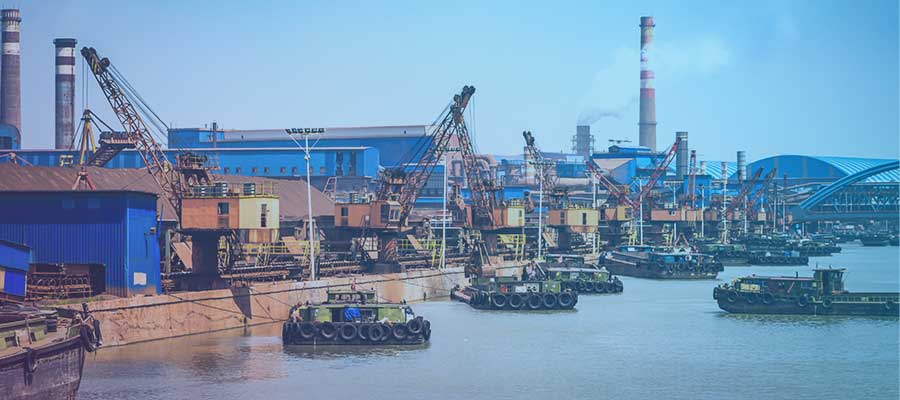
Background photo created by evening_tao - www.freepik.com
Roughly two thirds of the world’s fresh water usage is dedicated to agriculture, including irrigation, livestock and aquaculture. Approximately another 10% of water usage is for municipal purposes, including both domestic and public use.
Pretty much the rest of the world’s fresh water supply — a whopping 20% — is used by industry. In order to better steward this precious resource, there is a lot of pressure on both large and small factories to cut down the amount of water being used, and most importantly, the amount of water that is wasted. [1]
Water in Industry: Where is it being used?
The industries that are the largest consumers of water are smelting facilities and petroleum refineries, as well as the food, paper and chemical industries. [2] But water is essential to manufacturing in ways that most people are not aware of whatsoever. In order to keep heavy machinery from overheating, for example, water is used as a coolant. In most fabrication processes water is used as an agent to dilute chemicals, as well as in the cleansing process and the transportation of finished goods.
More and more companies are becoming aware of their water footprint and how it influences the enviromental future of the world. And it is about time that we all start being aware of the tremendous amount of water used in manufacturing everyday household objects. Here are some samples of everyday items and the amount of water used in manufacturing one item:
- An automobile – Average of 15,000 gallons
- A pair of leather shoes – 3,600 gallons
- A smartphone – 3,200 gallons
- A cotton bed sheet – 2,800 gallons
- A pair of jeans – 2,100 gallons
- A t-shirt – 650 gallons
At first glance this might seem like an unreasonable amount of water, but if you take a smartphone as an example and look at all of its individual components and the quantities of plastic and metals used to manufacture them, you will start seeing the whole picture. The phone’s water footprint also takes into account the amount of water required to clean the chemical waste created during the manufacturing process. [3]
In order to be a responsible consumer — or manufacturer — here are two free online calculators that you can use to assess a product’s water footprint:
The Future—Minimizing the Footprint
As opposed to water used in irrigation, much of the the water used in manufacturing can be recycled and this is happening in most sectors of industry today. For example, the water needed to produce electricity is phenomenal: it takes 95 liters of water to produce just 1 kilowatt hour of electricity. According to the IEEE, in the United States alone over 200 million gallons of water are used to produce electricity—every day of the week, every week of the year. [4] In the early days of thermoelectric production, the water used as a coolant would run off directly into streams and rivers. However this practice raised the temperature of the stream or river water to the point that it caused damage to the flora and fauna. Today the water coolant is turned into steam and condensed, thus minimizing environmental damage and promoting a higher level of recycling. [5]
Many private manufacturers are taking initiatives, as well as using government grants, in order to reduce their water footprint. Coca Cola has spent over $2 billion on water conservation since 2003, including helping to set up water purification systems in rural areas that can’t provide centers on their own. In addition, Coca Cola closed a manufacturing facility in India for using too much groundwater that couldn’t be replaced by nature.
Dow Chemical is leading the way in research in water treatment technology. They have a two pronged strategy: reducing the amount of energy used in the process of water treatment, and expanding the reusability of wastewater.
DyeCoo Textile Systems has developed a fabric dyeing process that converts carbon dioxide into a liquid to be used in the dyeing process instead of water. Conventional dyeing methods use up to 40 gallons of water for every kilogram of fabric; DyeCoo’s technology uses almost half that amount. Companies such as Nike, Adidas and IKEA are already using this technology and are very pleased with the quality, the price, and the fact that they are saving so much water in the manufacturing process.
Final Note
Happily, there are many other examples of companies, large and small, doing what they can to preserve our water. From beer manufacturers like Millers and Coors who have reduced the amount of water used by 65%, to the use of desalinated water in many manufacturing processes, it is reassuring that so many companies are working towards innovative solutions to water needs.
And, of course, we at the Arad Group take great pride in knowing that our products and solutions help save millions of gallons annually by providing water usage data when and where it is needed, 24/7.
References
[1] Food and Agricultural Organization of the UN, Aquastat – Water Usage, 2016
[2] CDC, Industrial Water Uses in Manufacturing and Industry, October 11, 2016
[3] Grace Communications Foundation, The Hidden Water in Everyday Products, January 7, 2017
[4] Willie D. Jones, How Much Water Does it Take to Make Electricity September 12, 2011
[5] Seth W Snyder, Cooling water use in thermoelectric power generation and its associated challenges for addressing water-energy nexus, April 11, 2018